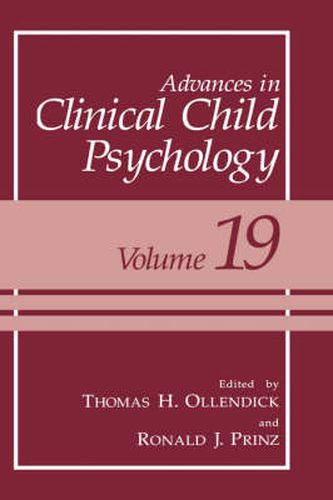Readings Newsletter
Become a Readings Member to make your shopping experience even easier.
Sign in or sign up for free!
You’re not far away from qualifying for FREE standard shipping within Australia
You’ve qualified for FREE standard shipping within Australia
The cart is loading…






This title is printed to order. This book may have been self-published. If so, we cannot guarantee the quality of the content. In the main most books will have gone through the editing process however some may not. We therefore suggest that you be aware of this before ordering this book. If in doubt check either the author or publisher’s details as we are unable to accept any returns unless they are faulty. Please contact us if you have any questions.
This nineteenth volume of Advances in Clinical Child Psychology continues our tradition of examining a broad range of topics and issues that charac terizes the continually evolving field of clinical child psychology. Over the years, the series has served to identify important, exciting, and timely new developments in the field and to provide scholarly and in-depth reviews of current thought and practices. The present volume is no exception. In the opening chapter, Sue Campbell explores developmental path ways associated with serious behavior problems in preschool children. Specifically, she notes that about half of preschool children identified with aggression and problems of impulse control persist in their deviance across development. The other half do not. What accounts for these differ ent developmental outcomes? Campbell invokes developmental and fam ily influences as possible sources of these differential outcomes and, in doing so, describes aspects of her own programmatic research program that has greatly enriched our understanding of this complex topic. In a similar vein, Sara Mattis and Tom Ollendick undertake a develop mental analysis of panic in children and adolescents in Chapter 2. In recent years, separation anxiety and/ or experiences in separation from attach ment figures in childhood have been hypothesized as playing a critical role in the development of panic. This chapter presents relevant findings in the areas of childhood temperament and attachment, in addition to experi ences of separation, that might predispose a child to development of panic.
$9.00 standard shipping within Australia
FREE standard shipping within Australia for orders over $100.00
Express & International shipping calculated at checkout
This title is printed to order. This book may have been self-published. If so, we cannot guarantee the quality of the content. In the main most books will have gone through the editing process however some may not. We therefore suggest that you be aware of this before ordering this book. If in doubt check either the author or publisher’s details as we are unable to accept any returns unless they are faulty. Please contact us if you have any questions.
This nineteenth volume of Advances in Clinical Child Psychology continues our tradition of examining a broad range of topics and issues that charac terizes the continually evolving field of clinical child psychology. Over the years, the series has served to identify important, exciting, and timely new developments in the field and to provide scholarly and in-depth reviews of current thought and practices. The present volume is no exception. In the opening chapter, Sue Campbell explores developmental path ways associated with serious behavior problems in preschool children. Specifically, she notes that about half of preschool children identified with aggression and problems of impulse control persist in their deviance across development. The other half do not. What accounts for these differ ent developmental outcomes? Campbell invokes developmental and fam ily influences as possible sources of these differential outcomes and, in doing so, describes aspects of her own programmatic research program that has greatly enriched our understanding of this complex topic. In a similar vein, Sara Mattis and Tom Ollendick undertake a develop mental analysis of panic in children and adolescents in Chapter 2. In recent years, separation anxiety and/ or experiences in separation from attach ment figures in childhood have been hypothesized as playing a critical role in the development of panic. This chapter presents relevant findings in the areas of childhood temperament and attachment, in addition to experi ences of separation, that might predispose a child to development of panic.